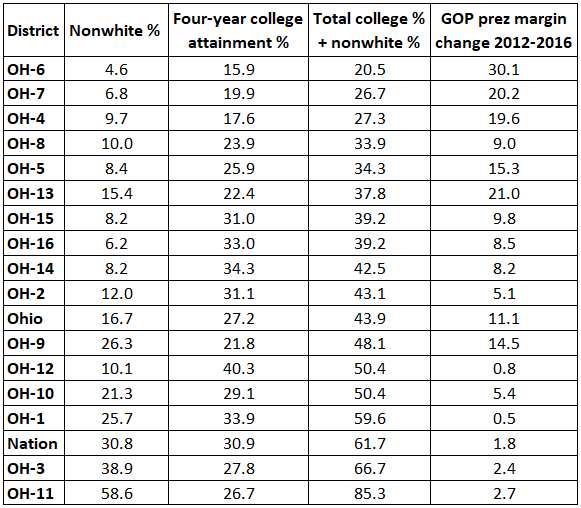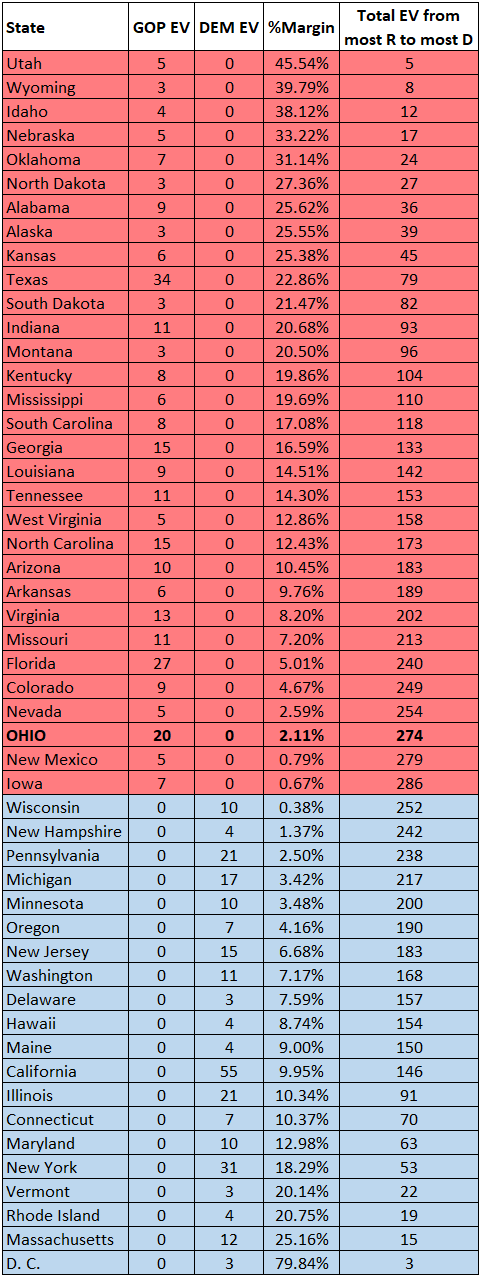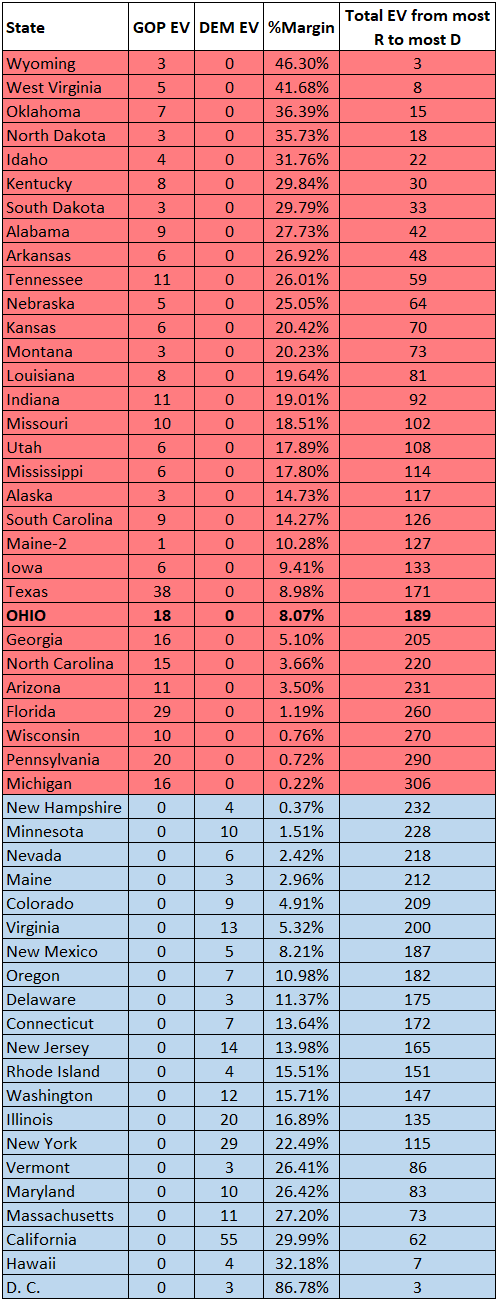The Democrats Descend on Ohio
A Commentary By Kyle Kondik
But will they next year?
KEY POINTS FROM THIS ARTICLE
— As the Democrats debate in Ohio, questions loom about how important the state will be in next year’s presidential election.
— Two key demographic indicators help explain why the state swung toward the Republicans in 2016 and why it seems likely to again vote to the right of the nation in 2020.
— The state remains competitive, but it’s far more important now to Republicans than Democrats.
Ohio in 2020
The Democrats’ decision to hold tonight’s presidential primary debate in Westerville, a Columbus suburb, re-ignited a simmering political discussion about Ohio. Can Democrats win it again after its turn toward President Trump in 2016? Or should they just abandon the state in favor of other opportunities?
It may be that the answer to both questions is yes.
In advance of the 2016 election, I wrote a book called The Bellwether, which recounted Ohio’s longstanding history at the center of American presidential voting. For more than a century, no state voted more often for the winning candidate or voted more consistently close to the national popular vote.
Ohio again voted for the winner in 2016, marking the 29th time in 31 elections it had done so.
However, it backed Donald Trump by eight points while Trump lost the national popular vote by two points, meaning that it was 10 points more Republican in terms of margin than the nation. Ohio’s presidential margin had not diverged so far from the national popular vote since 1932.
The shift in Ohio is best explained by two demographic realities that are driving voting patterns all over the nation: Ohio is significantly whiter than the nation as a whole, and its population has below-average levels of four-year college attainment. That means that Ohio has a relatively high share of white voters without a college degree, the group that now forms the bedrock of the Republican coalition (this was true before Trump, but is now more pronounced after Trump). Nonwhite voters, meanwhile, vote overwhelmingly Democratic, and white voters with a four-year college degree represent a swing demographic that is trending Democratic.
According to an analysis by Rob Griffin, Ruy Teixeira, and John Halpin for the liberal Center for American Progress, the 2016 national electorate was 45% non-college white, 29% whites with a four-year college degree, and 26% nonwhite. Meanwhile, Ohio’s electorate (based on the same report, which we respect), was 57% white without a college degree, 28% white with a college degree, and 16% nonwhite.
It is the case that some places in Ohio are getting more Democratic. Westerville, where the debate is being held tonight, is a good example. In 2012, Mitt Romney beat Barack Obama there by a little more than eight points; four years later, Hillary Clinton beat Trump there by about 4.5 points (these figures come courtesy of Cleveland.com’s Rich Exner). Westerville’s very high level of four-year college attainment (slightly over 50%) helps explain the shift away from the Republicans, as such highly-educated places are moving toward the Democrats all over the nation. Communities like Westerville, which is situated in both Columbus’s Franklin County as well as its suburban/exurban neighbor, Delaware County, pushed Clinton’s 2016 showing ahead of Obama’s 2012 margin in both counties.
It makes sense that Democrats would want to make further inroads in places like Westerville looking ahead to 2020.
The problem for Democrats in Ohio is that there aren’t enough places in the state that look like Westerville and are trending Democratic to make up for the many more places that don’t look like Westerville and are trending Republican.
Franklin and Delaware were two of only four of Ohio’s 88 counties where Clinton ran ahead of Obama in 2016 (the other two were Hamilton and Warren counties, which contain, respectively, Cincinnati and some of its suburbs). She did worse than him in the other 84, which isn’t surprising as she lost the state by eight points just four years after Obama won it by three, an 11-point net shift. Given that the overall national popular vote shifted only two points in the Republicans’ favor from 2012 and 2016, Ohio became considerably more Republican relative to the nation in the last presidential election.
Ohio’s voting is led, though not dominated, by three urban counties containing the state’s three big “C” cities: Cleveland (Cuyahoga), Columbus (Franklin), and Cincinnati (Hamilton). Together they cast nearly 30% of the statewide votes.
Collectively, Hillary Clinton did well enough in these counties to win in 2016: She fell off from Obama in Cuyahoga, but ran ahead in Franklin and Hamilton; overall, her margin in the three counties was just about 5,600 votes worse than Obama’s (in a state that casts a little more than 5.5 million votes for president). Meanwhile, Clinton’s margin in the rest of the state was about 608,000 votes worse than Obama’s. There are a lot of Ohio voters outside the big urban areas, and their communities generally are not very diverse and do not boast high levels of four-year college attainment. Clinton’s horrific performance in many of these places most contributed to her lopsided loss in the state.
One way to explain Ohio’s shifts is to analyze its 16 congressional districts through these two electorally-salient demographic features. Table 1 shows these districts, along with the state of Ohio as a whole as well as the nation, and features their share of adult residents over 25 with a four-year college degree and their share of citizen adult residents who are not white. I added these two shares together to create a Democratic index of sorts — basically, the higher a place’s combined share of nonwhite residents and residents over the age of 25 with a four-year college degree, the more resistant a place might be to Trump. Meanwhile, the lower that tally is, the more open a place probably will be to Trump.
Sure enough, this simple measure provides a decent guide to what happened in Ohio in 2016.
While every Ohio congressional district became more Republican from 2012 to 2016, the ones that are whiter and had lower percentages of four-year college attainment (the ones near the top of the table) generally shifted much further to the right than those that are diverse and/or highly educated (the ones near the bottom).
Furthermore, only two of Ohio’s 16 congressional districts had a higher combined four-year college and nonwhite index than the nation as a whole. And none of these congressional districts have as high a percentage of four-year college graduates as Westerville, which is mostly located in OH-12, a usually Republican and highly-educated district where Trump only improved slightly on Romney and where Democrats nearly won a nationally-watched U.S. House special election last year.
Meanwhile, no congressional district in the entire nation shifted more toward Trump than OH-6, an Appalachian district that runs along the Ohio River: At the start of the decade, the district was competitive enough that Ohio Republicans altered it in redistricting to help then-freshman Rep. Bill Johnson (R); by 2016, it was voting for Trump by 43 points. Unsurprisingly, it is both very white and has low levels of four-year college attainment.
Table 1: Ohio demographics by congressional district
Source: U.S. Census 2013-2017 American Community Survey as compiled by Daily Kos Elections. Presidential results by congressional district also compiled by Daily Kos Elections.
The bottom line is this: Without improvements among white voters without a four-year college degree, Democrats are likely going to have a hard time in Ohio.
However, it may be that the Democratic nominee is not doomed to perform as badly with these kinds of voters as Clinton did in 2016.
In 2016 in Ohio, Trump won white, non-college educated voters by a little over 30 points, according to the same Center for American Progress report cited above. That was up about 15 points in terms of margin from 2012, a shift that we can see reflected in the different kinds of congressional districts listed in Table 1.
Is Trump guaranteed to repeat this margin with non-college whites in 2020? No.
In late July, a Quinnipiac poll of Ohio found Trump’s approval rating with non-college whites was 53% approve, 42% disapprove; the pollster Civiqs, which is associated with the liberal website Daily Kos, pegs Trump’s approval with this group in Ohio at 58%/40%. If Trump’s actual electoral showing among non-college whites in Ohio next year were to mirror these approval ratings — a margin markedly lower than the 30-point gap he enjoyed in his favor in 2020 — the state would be back in play. However, if Trump replicates his 2016 showing with this group, only loses a little bit of backing, or actually improves his performance (as seems possible given the overall trajectory of this group of voters), the state probably isn’t winnable for the Democrats.
So if the question is can the Democratic presidential nominee win Ohio in 2020, the answer is yes, depending on Trump’s standing with non-college whites (and other factors).
But then there’s also the question as to whether Democrats should expend critical time and resources on targeting the state in the election, or focus on other places. That will be up to the nominee and his or her prerogatives, but in making that assessment, one has to look not just at Ohio, but the partisan ordering of the Electoral College.
The Electoral College lineup has been changing in ways that make Ohio more important to Republicans, and less important to Democrats.
First, let’s look back to 2004. That was the last time that Ohio was the decisive state in the Electoral College. Now, what does “decisive” mean? Table 2 orders all the states in 2004 by how well George W. Bush and John Kerry performed in those states from most Republican to most Democratic.
Table 2: 2004 presidential election from reddest to bluest
Note: Faithless electors ignored in Electoral College tallies.
Source: Dave Leip’s Atlas of U.S. Presidential Elections
Utah is listed at the top because it was Bush’s best state by margin; in a sense, then, Bush got his “first” electoral votes from Utah. The remaining Bush-won states (shaded in red) are then listing in descending order of margin.
The bottom of the table shows the places John Kerry won (shaded in blue). Kerry’s best margin came in Washington D.C., so he got his first electoral votes there.
The margins get closest in the middle, and notice that the state that puts Bush over 270 is Ohio. While Bush also won Iowa and New Mexico that year, they were closer than Ohio and ultimately superfluous to the outcome: had Kerry won Ohio, he would have won the election. Kerry actually performed fairly well in Ohio, losing it by 2.1 points while losing nationally by 2.5 points. This was one of the few times since 1896 where Ohio actually voted to the left of the nation, but Ohio also voted very close to the national popular vote, as it has with more regularity than any other state for decades.
But notice, too, that the ordering of the states was different back then. Most notably, Colorado and Virginia were clearly right of center back then, and New Mexico was a swing state. Now let’s jump ahead a dozen years, to 2016, as shown in Table 3. The table is organized in the same way as Table 2, with the most Republican states starting at the top and the most Democratic ones starting at the bottom.
Table 3: 2016 presidential election from reddest to bluest
Note: Faithless electors ignored in Electoral College tallies. Maine’s Second Congressional District is separated from Maine’s overall tally because it provided Trump an electoral vote while Clinton was otherwise carrying the state.
Source: Dave Leip’s Atlas of U.S. Presidential Elections
Note that Ohio was relatively far from casting the decisive 270th electoral vote, while Colorado, New Mexico, and Virginia have clearly flipped to the blue side of the ledger. Some of the key states in 2016 that are getting outsized attention in 2020, such as Michigan, Pennsylvania, and Wisconsin, are near the middle of both tables. Some other Democratic targets, such as Arizona, Florida, Georgia, and North Carolina, are closer to the middle now than they were back in 2004.
Ohio has always been more important to Republicans than Democrats; since the founding of the GOP in advance of the 1856 presidential election, there have been 41 presidential elections. Ohio has voted for the Electoral College winner in 36 of those elections, and the five times it voted for the losing candidate, it backed a losing Republican over a winning Democrat (the last time that happened was 1960, when Ohio voted for Richard Nixon over John F. Kennedy).
Now that the Republicans seem to be at a disadvantage in Colorado, New Mexico, and Virginia — in close national elections, anyway — winning Ohio is even more of a necessity than it was previously. But now that Democrats can count on those additional states, Ohio becomes more superfluous to them, even as other states that share demographic similarities to Ohio (Michigan, Pennsylvania, and Wisconsin, none of which ever voted for George W. Bush) remain electorally paramount.
Presumably, if Democrats are making inroads among white, non-college voters — not winning those voters, but losing them by less — that would boost their fortunes across the Midwest. Modest improvement with those voters would flip Michigan, Pennsylvania, and Wisconsin, whereas Ohio would require a stronger shift given that the other states are more Democratic.
Ohio merits monitoring, therefore, because it will tell us something about its more electorally salient regional compatriots.
If polling in Ohio is close next year, and if the state becomes strongly contested, it will be a bad sign for Trump. Winning Ohio is a necessary but not sufficient condition for Republican presidential victory historically, and that is particularly true for Trump. So a closer outcome in Ohio probably would also be indicative of broader trouble for the president in states that powered his 2016 victory.
If Ohio doesn’t seem particularly close, Democrats can still win the presidency, but that might indicate the Democratic candidate is not making the kind of inroads with non-college whites needed to reclaim needed electoral votes in the Midwest.
This is why I think the answer to the two questions posed at the top of this article is yes.
The state is not necessarily hopeless for Democrats, particularly if Trump’s huge 2016 margins among white voters without a four-year college degree erode to some degree.
But because of shifts in the ordering of states from most Republican to most Democratic, the Democrats don’t really need Ohio to win an Electoral College majority.
Kyle Kondik is a Political Analyst at the Center for Politics at the University of Virginia and the Managing Editor of Sabato's Crystal Ball.
See Other Political Commentary by Kyle Kondik.
See Other Political Commentary.
This article is reprinted from Sabato's Crystal Ball.
Views expressed in this column are those of the author, not those of Rasmussen Reports. Comments about this content should be directed to the author or syndicate.
Rasmussen Reports is a media company specializing in the collection, publication and distribution of public opinion information.
We conduct public opinion polls on a variety of topics to inform our audience on events in the news and other topics of interest. To ensure editorial control and independence, we pay for the polls ourselves and generate revenue through the sale of subscriptions, sponsorships, and advertising. Nightly polling on politics, business and lifestyle topics provides the content to update the Rasmussen Reports web site many times each day. If it's in the news, it's in our polls. Additionally, the data drives a daily update newsletter and various media outlets across the country.
Some information, including the Rasmussen Reports daily Presidential Tracking Poll and commentaries are available for free to the general public. Subscriptions are available for $4.95 a month or 34.95 a year that provide subscribers with exclusive access to more than 20 stories per week on upcoming elections, consumer confidence, and issues that affect us all. For those who are really into the numbers, Platinum Members can review demographic crosstabs and a full history of our data.
To learn more about our methodology, click here.



